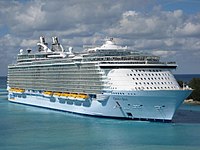
Photo from wikipedia
Abstract This work presents a series of experiments performed with a prismatic hull form in a small wave flume. The model is a midship section with rectangular damage opening on… Click to show full abstract
Abstract This work presents a series of experiments performed with a prismatic hull form in a small wave flume. The model is a midship section with rectangular damage opening on the side. It is slightly smaller than the flume breadth to achieve predominantly two-dimensional behavior in the experiments. Freely-floating tests in regular beam-sea waves have been carried out on the model section in intact and damaged conditions. Free-roll decay tests were performed for intact and damaged sections to understand the effect of floodwater on roll natural period and roll damping of the model. Video recordings and measurements of wave elevation inside the damaged compartment were performed in all experiments. Linear response amplitude operators (RAOs) for water elevation inside the model and model motions are presented and discussed. Effect of wave steepness, wave period, initial loading condition, damage-compartment division about centerplane (symmetric/asymmetric flooding), damage-opening size and air compressibility in the damaged compartment are examined. The presented results demonstrate occurrence of sloshing and piston mode resonances and their influence on damaged ship motions in waves is highlighted. A linearized strip theory method based on viscous flow is implemented to cross-check and complement the experimental results. The latter method can estimate the damaged ship motions with reasonable accuracy. The initial loading condition determines the equilibrium flooding state and, therefore, the sloshing and piston mode resonance frequencies of the flooded water. The damage-opening size mainly affects the roll damping behavior of the section. Air compressibility in the airtight compartment acts as a coupled spring system with the floodwater and restricts the free-surface motion in the damaged compartment. Cases of transient flooding for a damaged section are also presented, where the freely floating model moves in beam-sea waves and subsequent flooding takes place. Effect of wave steepness, incident wave period and initial intact stability of the model is examined for this scenario. The present work is a continuation of a series of experiments conducted on the same damaged section for forced heave motions documented in [1] . Due to the complex and nonlinear behavior of floodwater inside a damaged ship section, as the previous analysis, the current work is aimed to contribute in the physical understanding of ship behavior in damaged conditions, as well as to serve as a database for the research community to be used for numerical validation.
Journal Title: Applied Ocean Research
Year Published: 2020
Link to full text (if available)
Share on Social Media: Sign Up to like & get
recommendations!